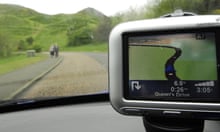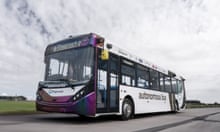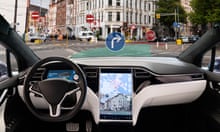In a little over two years, a fleet of driverless cars will make its way from Oxford to London, completing the entire journey from start to finish without human intervention, including on urban streets and motorways.
Organisers of the government-backed project, announced on Monday, still expect to have a human in the driving seat. But as the cars communicate, update on hazards, and automatically react, is the time coming when a human driver is not just redundant but an active danger?
A driverless transport trial started this month in Greenwich, south-east London, with members of the public invited to climb aboard Harry – a version of the pod vehicles used at Heathrow’s Terminal 5, souped-up with lasers, sensors and £20,000 worth of autonomous technology.
Harry was doing a careful 15mph beside the Thames when an oncoming jogger swerved right in front of us, forcing the vehicle to a sudden halt. In other circumstances, road rage might result; the jogger stared in, did a double-take, and ran off. Harry had saved him a trip to A&E, and had not even given him a self-righteous earful.
In this GATEway – Greenwich Automated Transport Environment – experiment researchers will examine how humans will interact with completely autonomous vehicles, whether preconceptions shift and what might impede the introduction of the technology.
The autonomous future, proponents say, should be much safer. According to various studies, including by the US Department of Transportation, about 90-95% of road crashes involve human error. The World Health Organization estimates 1.25 million people die each year on the road. Given the statistics, should human drivers eventually be banned altogether?

The roadmap from here to autonomy, as defined internationally by engineers and transport authorities, locates car users now at level two, where some of the driver’s tasks are automated and assisted. The next stage, coming as early as next year, allows the car to take over on certain roads, such as motorways, but with the driver ready to retake control, and still required for many situations. The Oxford-London trial is at level four, where cars can pretty much do all the driving, under human supervision – and should be widespread in eight years, the motor industry believes. From 2030, it is forecast that vehicles will be sufficiently autonomous that drivers are no longer necessary.
The trickiest part of this journey, many think, is what lies just ahead, an era where there are both cars driven by humans and driverless vehicles on the roads. In this immediate future, there is no doubt which the experts – and insurers – believe will be the bigger danger.
At a recent conference on connected cars held by the UK industry body the Society of Motor Manufacturers and Traders, Britain’s biggest motor insurer, Direct Line, said that driving by humans “may increasingly become a luxury pursuit”. Insurance premiums will be far higher for those who drive themselves, and correspondingly lower for automated cars.
“Absolutely, we will push people in that direction,” said Gus Park, the insurer’s managing director for motor and business development, but added: “We’re going to be in a pretty complicated mixed environment for some time.” He compared the period ahead to when horse-drawn vehicles were eventually withdrawn from major roads; the car owner of the future may have to buy it a paddock.
Paul Newman, the founder of Oxbotica, which will run the Oxford-London trial and developed the autonomous technology for vehicles including the Greenwich pod, said the question becomes: at what point does the government have a duty of care to intervene in the face of statistics that are likely to show human drivers cause thousands of deaths a year? Newman points out that in the past governments have answered this question by enforcing the wearing of seatbelts to reduce road deaths.His colleague, Oxbotica’s chief executive, Graeme Smith, put it another way: “If we have a vehicle that is 10 times safer than a human driver, wouldn’t it be criminal to let the human driver in?”
Incentives and controls are perhaps more likely solutions than an outright ban – rather like smoking, driving may become increasingly costly and permitted in ever fewer places. Thorny questions of prohibition may be dodged in favour of, for example, licensing fast lanes for connected, self-driving cars, or creating urban zones where shared, autonomous, electric vehicles of some description become the only mode of transport, reshaping mass public transport.
In the meantime, young people’s appetite to drive or own cars is expected to fade, with the likes of Uber and carpooling already making the motor industry revise how it will sell its vehicles in years to come.
The consensus among those thinking about the driverless future is that social attitudes and politics will keep humans in the driving seat for a decade or two longer than technology requires. But eventually, beyond the enthusiast on private roads, tending a beloved antique, is the car driver heading the way of the dodo?
Prof Nick Reed, of TRL, a future transport consultancy that is leading the Greenwich trials, said: “If human driving is the main source of risk, and you’ve ended up at a place where mobility is more available, efficient, greener and cheaper, then why wouldn’t you do away with them?”










Comments (…)
Sign in or create your Guardian account to join the discussion